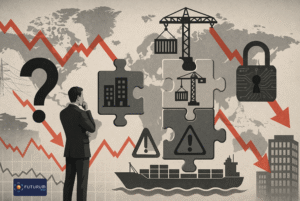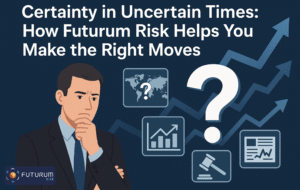Why the Smartest Equity Investors Are Doubling Down on More Than Just Returns
The landscape of private equity has undergone a seismic shift in the past decade. Once dominated by an almost singular pursuit of financial return, equity investors today are reshaping the market by integrating purpose and long-term impact into their investment thesis.
This evolution isn’t just a feel-good trend, it’s fast becoming a strategic necessity. From climate risks to shifting regulatory frameworks, from Gen Z’s demand for authentic corporate purpose, to LPs demanding transparency, private equity is being redefined. Investors who fail to embrace this shift risk being left behind in an increasingly evolving market.
This blog explores why purpose-led investing is the next frontier in private equity, how firms are embedding ESG and sustainability into due diligence and value creation, and what this all means for risk professionals, portfolio managers, and allocators navigating this new terrain.
What Exactly is ESG?
ESG stands for Environmental, Social, and Governance, three critical pillars that investors use to evaluate the sustainability, ethical practices, and overall long-term viability of a company. These factors are now key to assessing both financial performance and the broader impact a company has on the world.
- Environmental: Investors are increasingly focused on how companies mitigate environmental risks, such as exposure to extreme weather events or disruptions in supply chains due to climate change. Examples include a company’s strategy for reducing its dependence on fossil fuels, its use of renewable energy, and how it addresses climate-related regulations that may impact its future operations. For instance, a company that has adapted its infrastructure to withstand more frequent flooding in coastal areas or one that has developed resilient supply chain practices in the face of global resource scarcity is seen as more future-ready.
- Social: Social risks are becoming a key consideration for investors as they evaluate how companies manage relationships with their workforce and communities. This includes assessing labour rights compliance, but also the risk of employee turnover due to poor workplace culture or unsafe working conditions. For example, companies that have proactive diversity and inclusion policies are seen as better equipped to handle societal shifts, while those that manage community relations effectively, especially in areas of conflict or unrest, show resilience against reputational risks.
- Governance: Strong governance practices are critical in ensuring a company’s long-term success and minimising risk exposure. Investors look at how a company’s leadership handles regulatory compliance, executive compensation, and board oversight. A good example is a company that has implemented robust internal controls to prevent fraud and corruption, or one that has transparent financial reporting and clear risk management policies. This also includes how well companies adapt to evolving governance regulations, such as data privacy laws or anti-money laundering standards.
Once considered an optional lens, ESG is now a serious investment criterion. Investors are no longer asking “Can this business grow?”, they’re also asking, “Should it?” and “Will it be resilient tomorrow?”
“Historically, ESG was often siloed as a compliance checkbox or a ‘soft’ add-on. But not anymore.” – Bain & Company
This was backed by a 2024 report from Preqin that noted ESG-aligned funds outperformed their traditional counterparts in both resilience and return. Bain & Company’s private equity insights suggested that portfolio companies with clear sustainability strategies see a 20–30% increase in exit multiples compared to peers. Why? Because stakeholders, from regulators to talent, are demanding it. And in many ways, ESG is becoming a proxy for future-readiness.
Key Performance Indicators (KPIs) are shifting too. Beyond Earnings Before Interest, Taxes, Depreciation, and Amortisation (EBITDA) and revenue growth, investors are tracking carbon intensity, supply chain transparency, DEI metrics, and even employee sentiment scores. These KPIs aren’t charity; they are strategic assets and risk mitigators.
Risk Management: From Loss Prevention to Long-Term Growth
Risk management in private equity is shifting focus too. It’s no longer solely about mitigating potential losses; it’s about developing strategies that position portfolios to thrive in an evolving market, ensuring long-term growth and adaptability. One of the most transformative shifts in equity investing is the way risk is understood.
In the old model, risk was something to hedge or avoid. But in the emerging purpose-led model, risk is approached as a lever for value creation.
For example, climate risk is no longer just a downside factor, it’s a signal for which sectors and technologies are poised to grow. A company’s exposure to regulatory scrutiny isn’t merely a red flag, it’s a prompt for proactive governance that can drive valuation premiums.
This perspective is particularly relevant to Futurum Risk readers, those who understand that risk is dynamic, contextual, and now increasingly reputational.
“Risk is no longer about avoiding losses but about creating resilience. Investors are looking at how to manage the bigger risk picture to proactively respond to opportunities.” James Ellender
The Due Diligence Revolution
Gone are the days when due diligence focused solely on balance sheets and competitive positioning. Today’s equity investors are digging deeper, into supply chains, emissions disclosures, labour policies, and board diversity.
What’s more, “impact materiality” is the new north star. Investors are assessing not only how the outside world affects a company (financial materiality), but how the company affects the world (impact materiality). This dual lens is giving rise to smarter, more ethical, and more resilient portfolios.
Some firms are even using satellite data to monitor land use and biodiversity in their agri-business investments, or leveraging AI to predict ethical risks in global labour chains. The bar is being raised.
At Futurum Risk, we partner with equity investors and asset managers to make purpose-led investing real. Our enhanced due diligence, risk intelligence, and governance solutions are designed to dig deeper, spotting ESG gaps, surfacing reputational risk, and giving you clear visibility on the issues that matter.
“At Futurum Risk, we work alongside equity investors to help them integrate purpose-led strategies throughout their portfolios, from pre-deal to post-acquisition, ensuring long-term impact.” – James Ellender
How Tech is Enabling Purpose-Led Capital
- Emerging technologies are turbocharging this movement. AI and Natural Language Processing tools are screening thousands of pages of company disclosures for ESG red flags in seconds.
- Blockchain is being used to ensure traceability in supply chains, giving LPs and regulators real-time assurance.
- Digital twins of factories and buildings are simulating carbon outputs before capital is deployed.
This tech-infused approach is lowering the cost of transparency and creating a future where real-time ESG reporting becomes the norm. For private equity firms, the message is clear: get ahead of the curve or get left behind.
The New Role of LPs: Capital with Conviction
Limited Partners, from sovereign wealth funds to family offices, are no longer passive sources of capital. They’re active catalysts for change.
The largest LPs are now demanding ESG-aligned mandates and are divesting from GPs who fail to integrate purpose authentically. In 2025 and beyond, the balance of power is tilting toward those who can not only generate alpha but defend it with a conscience.
According to a 2024 survey by the Global Impact Investing Network, 72% of LPs plan to increase their allocation to purpose-led private equity funds over the next three years.
“LPs are no longer passive investors. They’re now seeking purpose-driven mandates and divesting from GPs who fail to incorporate ESG meaningfully into their strategies.” David Wood, Managing Director at Preqin
What Equity Investors Are Really Asking About ESG & Purpose-Led Investing
Insights from the frontlines, straight from conversations our Managing Director, James Ellender, has had with GPs, LPs, and risk professionals.
What’s actually happening in private equity right now when it comes to ESG and purpose?
“We’re seeing a definite shift. Some firms have really started to embed ESG into how they think about value and growth. Others are still lagging, or doing the bare minimum. It’s no longer enough to just talk about ESG, LPs are asking, ‘Where’s the evidence?’ It’s becoming part of the commercial conversation.”
Is ESG really driving performance, or is this still just a nice-to-have?
“It’s driving performance. We’ve seen it firsthand , businesses that take ESG seriously are often better run, more resilient, and frankly, more attractive at exit. It’s not about being perfect; it’s about showing that you’ve got a grip on the risks and opportunities that matter.”
What are the biggest red flags when it comes to ESG in due diligence?
“No plan, no leadership buy-in, and no accountability. If ESG sits with one junior person and never makes it to the boardroom, that’s a red flag. Also, if a firm can’t show you how they measure impact, or worse, if they avoid the question, it tells you they’re not ready.”
Can purpose-led investing really add value?
“Yes. Not always in a straight line, but over time, it pays off. Whether it’s reduced churn, stronger brand loyalty, or fewer regulatory headaches , we’ve seen value created in portfolios where ESG is done well. And buyers are looking for it too.”
How do you think about risk and purpose — are they at odds?
“Not anymore. Managing ESG risks is part of managing overall risk. If you’re not factoring in climate exposure, for example, or reputational risk from a poor supply chain, you’re missing big chunks of the risk picture.”
Which sectors are actually changing because of ESG investment?
“Energy, food production, consumer goods , we’re seeing big changes there. But to be honest, it’s touching every sector in some way. The ones with the biggest regulatory pressure or consumer scrutiny are moving fastest.”
Have LPs really changed what they’re looking for?
“Absolutely. They’re asking better questions, digging deeper, and walking away if they don’t like what they see. Some LPs won’t even take a meeting now unless ESG is clearly part of your mandate. It’s gone from being a differentiator to a basic expectation.”
Is technology helping with ESG, or just adding more noise?
“When it’s used well, it’s a game-changer. We’ve seen AI tools that pick up ESG risks in disclosures you’d miss otherwise. Blockchain’s helping with supply chain traceability. It’s early days for some of it, but the direction is clear, data’s becoming more available, and that helps everyone.”
Where do you see private equity heading in the next 3–5 years on this?
“There’ll be more pressure for transparency and accountability, not just from LPs, but from regulators and the public too. Funds that can demonstrate real impact, not just talk about it, will be the ones that raise faster and get better exits.”
What would you say to new managers trying to build purpose into what they do?
“Don’t overthink it. Start with what’s material to your sector, and don’t try to do everything at once. Make sure your ESG goals are tied to how you plan to grow and manage the business. And document it, LPs want to see how you think, not just what you say.”
Purpose-Led Investing, The Path Forward
Purpose-led investing is no longer just a trend , it’s a strategic necessity. Investors are recognising that integrating ESG is a powerful tool for long-term value creation and risk mitigation. By embracing this shift, equity investors can foster resilience, build stronger reputations, and tap into emerging markets focused on sustainability.
As technology advances, tools like AI, blockchain, and real-time data are making it easier than ever to track and improve ESG metrics. However, the true challenge lies in integrating these practices at every stage , from due diligence to post-acquisition monitoring.




